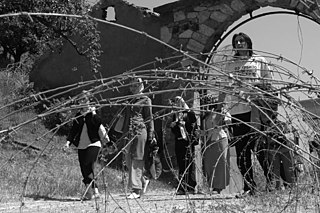
Serbian epic poetry is a form of epic poetry created by Serbs originating in today's Serbia, Bosnia and Herzegovina, Croatia, Montenegro and North Macedonia. The main cycles were composed by unknown Serb authors between the 14th and 19th centuries. They are largely concerned with historical events and personages. The instrument accompanying the epic poetry is the gusle.

On 17–18 March 2004, violence erupted in the partitioned town of Mitrovica, Kosovo, leaving hundreds wounded and at least 14 people dead. The unrest was precipitated by reports in the Kosovo Albanian media which claimed that three Kosovo Albanian boys had drowned after being chased into the Ibar River by a group of Kosovo Serbs. UN peacekeepers and NATO troops scrambled to contain a raging gun battle between Serbs and Albanians. Serbs call the event the March Pogrom, while the Albanians call it the March Unrest.

Opolje is a region in the southern part of the municipality of Prizren in southern Kosovo. The region has 19 villages mainly inhabited by Kosovo Albanians.
Golaj is a village and a former municipality in the Kukës County, northeastern Albania. At the 2015 local government reform it became a subdivision of the municipality Has. The population at the 2011 census was 6,187. In the Ottoman Defter of 1571 for the Sanjak of Dukagjin, Golaj was part of the Nahiya of Pashtrik and was part of the timar of Hasan. The inhabitants of Golaj had a predominantly Christian Albanian anthroponomy with a degree of Islamisation: Mustafa Koka, Iljas Koka, Hasan Deja, Ali Deja, Memi Tusha, Ali Puta, Hasan Tola, Ahmed Benku, Papa Deja, Deda Papa, Tita (Dida) Gjeci, Prend Tita (Dida), Deda Kola, Benk Gika, Gjon Gjika, Mark Koka, Gjin Deja, Gjin Lika, Tola Koka, Gjon Lika, Gjin Andrea, Nina Gjoni, Papa Tola, Kola Bardi, Papa Nina, Papa Baci, Puta Gika, Bac Puta, Draga Progoni, Deja Lika, Gjon Lika, Draga Maza, Gjon Lika, Progon Gjura, Lika Progoni, Diraga Draga, Vata Gika, Kraga Gika, Gjon Vata, Biba Gaci, Mark Gaci, Gika Dida, Gjec Deda, Lika Kola. There were 35 Christian homes in total, and 8 Muslim household heads - all Albanian.

The Monastery of the Holy Archangels is a Serbian Orthodox monastery located in Prizren, Kosovo. The monastery was founded by the Serbian Emperor Stefan Dušan between 1343 and 1352 on the site of an earlier church, part of the Višegrad fortress complex. It was the burial church for Emperor Dušan, and represented the culmination of the Serbian ecclesiastical architectural style, that led to the birth of the Morava school style.
Gornji Bučumet is a settlement in the municipality of Medveđa, in southern Serbia. According to the 2002 census, the village had a population of 139 people.
Skorobište or Skorobišta (Скоробишта) is a village in Prizren Municipality, Kosovo.
Strellc i Epërm or Gornji Streoc, meaning "Upper Streoc", is a village in the Deçan municipality of western Kosovo, located between Deçan and Pejë along the mountainous border with Albania. The majority of inhabitants are ethnic Albanians.
Carrabreg i Poshtëm Serbian: Доњи Црнобрег) or Donji Crnobreg is a village in the Deçan municipality of western Kosovo. It is located in the Dukagjini basin between Deçan and the village of Prilep along the mountainous border with Albania. The majority of the population comprises ethnic Albanians.

Aljinovići is a village in the municipality of Prijepolje, Serbia. According to the 2002 census, the village has a population of 196 people.

Zhegër or Žegra is a village in the Gjilan district of Kosovo. It is located in the Karadak region on the banks of the Žegra river, a right tributary of the Binačka Morava, at the foot of Kušljevica, on both sides of the road towards Donja Budriga.
Hasan Zvizdić (1892–1980) was a Sandžak Muslim commander of a detachment of the collaborationist Muslim militia from Sjenica during the Second World War. He was the main livestock wholesaler in the region which depended on animal husbandry, thus his influence in Sandžak was strong.
The First Balkan Alliance was a system of agreements concluded by the Principality of Serbia in the period of 1866–68 to unite the nations of the Balkans in a common struggle against the Ottoman Empire. The plans for forging this alliance were based on the organization of a major general uprising, as opposed to individual uprisings by the various ethnic groups in Ottoman territory. According to the plans, the Albanians would begin the uprising, followed by Serb and Greek volunteers and finally and simultaneously by the regular armies of Serbia and Greece. According to the plans and agreements, after a successful war against the Ottomans, the Balkan nations would establish a united federation.
Damjan is one of the largest villages in the District of Gjakova, Kosovo.
Romajë is a village in the Prizren municipality of Kosovo. It has 2,747 inhabitants as of 2011. The area of Romajë is the site of a multi-layered settlement of the pre-Roman Iron Age, the Roman era, and the medieval era. Excavations at the necropolis of Romajë have revealed extensive burial mounds (tumuli) of classical antiquity.
Sarosh is a village in the municipality of Rahovec, district of Gjakova, in Kosovo. Sarosh is situated nearby to the villages Dabidol and Qifllak.
Guskë is a village in District of Gjakova, Kosovo. Guskë is situated nearby to the village Korenice and the hamlet Rrasa e Gjoni. The village is part of the Has region.
Vogovë is a village in the District of Gjakova, in Kosovo. Vogovë is situated nearby to the village Zhub and Rrasa e Gjoni. The village of Vogovë is situated within the Has region.
Krajk is a village in Prizren, Kosovo. Krajk is situated nearby to the hamlet Basarinë and the village Pirane.








